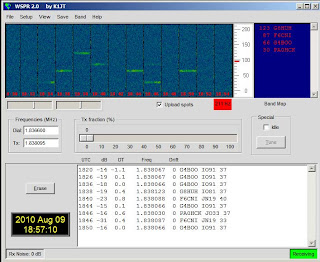12 Aug 2010
10m halo re-erected
Today I rebuilt my Homebase10 10m wire halo and put it back up on the pole. I was going to erect a spiral top hat vertical for LF but decided instead to go HF. VSWR was good from 28-29MHz and WSPR reports from G4IKZ (18km west) good with just 1W out. I can use this antenna, with feeder strapped, as a vertical on 500kHz. For 136kHz I've decided to erect a wire loop rather than a Marconi and will support this from the 10m antenna mast.
Labels:
10m,
homebase10,
wspr
10 Aug 2010
417km on 500kHz QRP ....with just earth electrode antenna!
Just been received in Holland by PA0A on 500kHz WSPR when using just the 20m spaced earth electrodes! The ERP is around 250uW and I am amazed that this non-antenna is able to work so well. I've also been emailed by Victor PA3FNY to say he also copied me at -27dB S/N.
500kHz WSPR with 20m spaced earth electrode antenna
The effectiveness of the 20m spaced earth electrode "antenna" (virtually nothing is in the air) continues to amaze me. Last night I copied PA0O on 500kHz WSPR and this morning I've got 4 reports of my sub-1mW ERP signal from M0BMU around -19dB S/N at a distance of 69km. This level suggests the (non) antenna is only around 6-8dB down on my best top loaded short vertical used to get reports from OK2BVG 1232kms away last winter and the ERP is around 200-250uW.
Labels:
500kHz,
earth electrodes,
wspr
9 Aug 2010
160m WSPR receive with earth electrodes
Although I've not matched the 20m spaced earth electrodes yet on 160m, it makes a fine RX antenna. See the logs on WSPR in just the last hour.
500kHz WSPR
This afternoon I restarted 500kHz WSPR transmissions using about 250uW ERP from the earth electrode "antenna" in the ground. Two reports received from M0BMU at 69km received so far (-24/-25dB S/N). In the next few days I'm hoping to erect a vertical top loaded Marconi antenna to use on both 136 and 500kHz, so it will be interesting to see how reports compare with those obtained on the earth electrode antenna.
8 Aug 2010
500kHz with the Elecraft K3
On the Elecraft website I see there is an article showing how to use the K3 transceiver on 500kHz. The K3 will receive on 500kHz but needs an external PA (described) to get around 25W output. See http://www.elecraft.com/TechNotes/k3qtx_v2_pa3cw.pdf
5 Aug 2010
FT818 - a "what if" radio that does not exist....
The FT818 handheld:
- All mode, all bands 1.8-1296MHz with 5MHz and 70MHz
- 5W RF (2W 1296MHz)
- 3.5AHr Li-Ion battery pack (2hr charging)
- Built in random wire and whip auto-ATU
- Full colour OLED display
- Multi-function DSP noise reduction
- RF Speech processor
Labels:
ft817 successor,
ft818
3 Aug 2010
US and Canadian East Coast Loran closed today
Apparently the very last Loran TX on the east coast of the USA and Canada closed at 0500 today. This will make reception on 136kHz much easier in this part of the world. At one time Loran was one of the most popular navigation systems in the world but now made obsolete by GPS units costing a few dollars and fitting in your pocket.
2 Aug 2010
14.9km on 136kHz QRP (earth electrode antenna)
This morning I did some more tests using my little 136.93kHz 2W QRSS3 beacon feeding into the 20m spaced earth electrodes. The TX end was unchanged, but this time on receive I used my 30t 80cm loop resonated with about 700pF and fed straight into the high impedance input of my E-field probe. Results were as follows:
- At 2.4km good copy by ear (12wpm CW would have been very solid)
- At 8.6km good copy using Spectran
- At 14.9km clear copy of my callsign and locator in QRSS3 with Spectran on the Gog Megog Hills near Cambridge (see screenshot)
- 2W out crystal controlled QRP 136kHz beacon TX on a 5 x 5cm board (see picture)
- Invisible ground "antenna" that can't be seen, even when a few metres away from it.
- No attempt to match the TX to the earth electrodes.
- Simple loop + FET impedance matching circuit and deaf FT817 at the receiver end.
Labels:
136khz,
6m qrp,
earth electrodes,
qrss
1 Aug 2010
DK7FC's 6th VLF kite TX experiment
Stefan DK7FC is testing his 600W VLF transmitter into a 200m high kite supported vertical today (Aug 1st). He expects to radiate about 10dB more than in his last test (on 8.97kHz) and may transmit at a slightly lower frequency today (around 6.5kHz) depending on where the antenna is best matched. You can check progress on his grabber at http://www.iup.uni-heidelberg.de/schaefer_vlf/DK7FC_VLF_Grabber2.html . Results from his last tests were amazing with reception across Europe in DFCW600 mode (dual frequency slow CW). For a summary of the reports (screen grabs) see http://abelian.org/vlf/
Subscribe to:
Posts (Atom)







